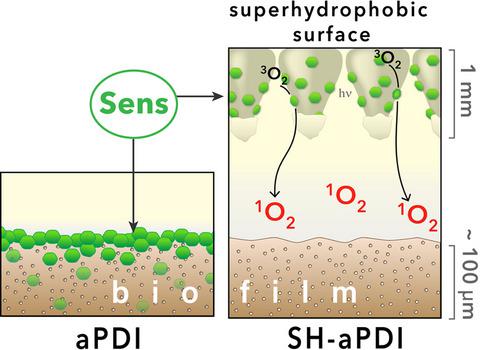当前位置:
X-MOL 学术
›
Photochem. Photobiol.
›
论文详情
Our official English website, www.x-mol.net, welcomes your
feedback! (Note: you will need to create a separate account there.)
Antimicrobial Photodynamic Inactivation Using Topical and Superhydrophobic Sensitizer Techniques: A Perspective from Diffusion in Biofilms†
Photochemistry and Photobiology ( IF 2.6 ) Pub Date : 2021-06-07 , DOI: 10.1111/php.13461 Caroline Coradi Tonon 1 , Shoaib Ashraf 1 , José Quílez Alburquerque 1, 2 , Alessandra Nara de Souza Rastelli 1, 3 , Tayyaba Hasan 1, 4 , Alan M Lyons 5, 6, 7 , Alexander Greer 6, 7, 8
Photochemistry and Photobiology ( IF 2.6 ) Pub Date : 2021-06-07 , DOI: 10.1111/php.13461 Caroline Coradi Tonon 1 , Shoaib Ashraf 1 , José Quílez Alburquerque 1, 2 , Alessandra Nara de Souza Rastelli 1, 3 , Tayyaba Hasan 1, 4 , Alan M Lyons 5, 6, 7 , Alexander Greer 6, 7, 8
Affiliation

|
This review describes nanoparticle and dye diffusion in bacterial biofilms in the context of antimicrobial photodynamic inactivation (aPDI). aPDI requires the diffusion of a photosensitizer (Sens) into the biofilm and subsequent photoactivation of oxygen for the generation of reactive oxygen species (ROS) that inactivate microbes. Molecular diffusion in biofilms has been long investigated, whereas this review is intended to draw a logical link between diffusion in biofilms and ROS, a combination that leads to the current state of aPDI and superhydrophobic aPDI (SH-aPDI). This review should be of interest to photochemists, photobiologists and researchers in material and antimicrobial sciences as is ties together conventional aPDI with the emerging subject of SH-aPDI.
中文翻译:

使用局部和超疏水敏化剂技术进行抗菌光动力灭活:生物膜扩散的视角†
这篇综述描述了抗菌光动力失活(aPDI)背景下细菌生物膜中的纳米颗粒和染料扩散。aPDI 需要光敏剂 (Sens) 扩散到生物膜中,随后对氧气进行光活化,以产生活性氧 (ROS),从而灭活微生物。生物膜中的分子扩散长期以来一直被研究,而本综述的目的是在生物膜中的扩散和 ROS 之间建立逻辑联系,这种组合导致了 aPDI 和超疏水 aPDI (SH-aPDI) 的当前状态。这篇综述应该引起光化学家、光生物学家以及材料和抗菌科学领域的研究人员的兴趣,因为它将传统的 aPDI 与新兴的 SH-aPDI 主题联系在一起。
更新日期:2021-06-07
中文翻译:

使用局部和超疏水敏化剂技术进行抗菌光动力灭活:生物膜扩散的视角†
这篇综述描述了抗菌光动力失活(aPDI)背景下细菌生物膜中的纳米颗粒和染料扩散。aPDI 需要光敏剂 (Sens) 扩散到生物膜中,随后对氧气进行光活化,以产生活性氧 (ROS),从而灭活微生物。生物膜中的分子扩散长期以来一直被研究,而本综述的目的是在生物膜中的扩散和 ROS 之间建立逻辑联系,这种组合导致了 aPDI 和超疏水 aPDI (SH-aPDI) 的当前状态。这篇综述应该引起光化学家、光生物学家以及材料和抗菌科学领域的研究人员的兴趣,因为它将传统的 aPDI 与新兴的 SH-aPDI 主题联系在一起。











































 京公网安备 11010802027423号
京公网安备 11010802027423号